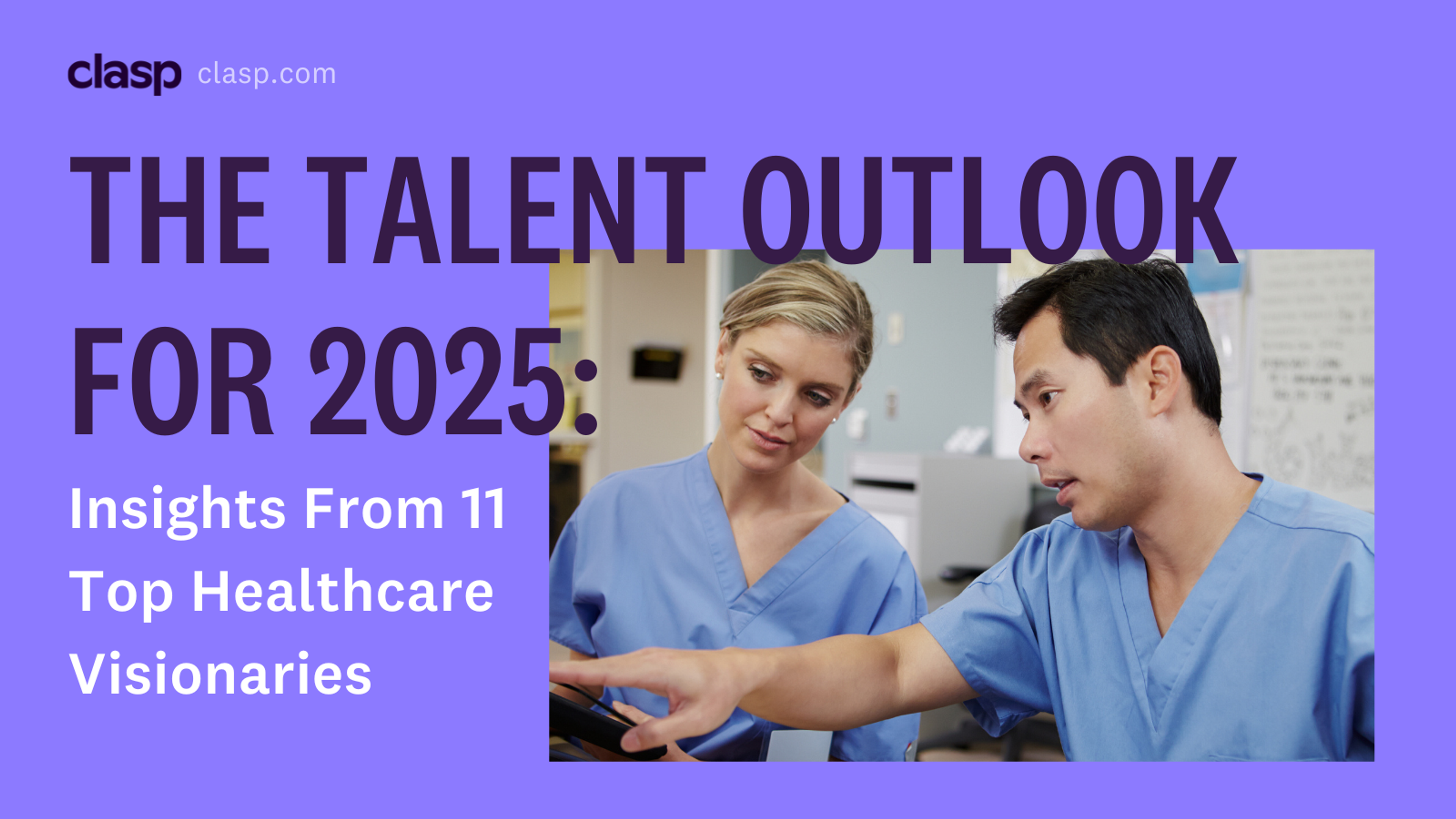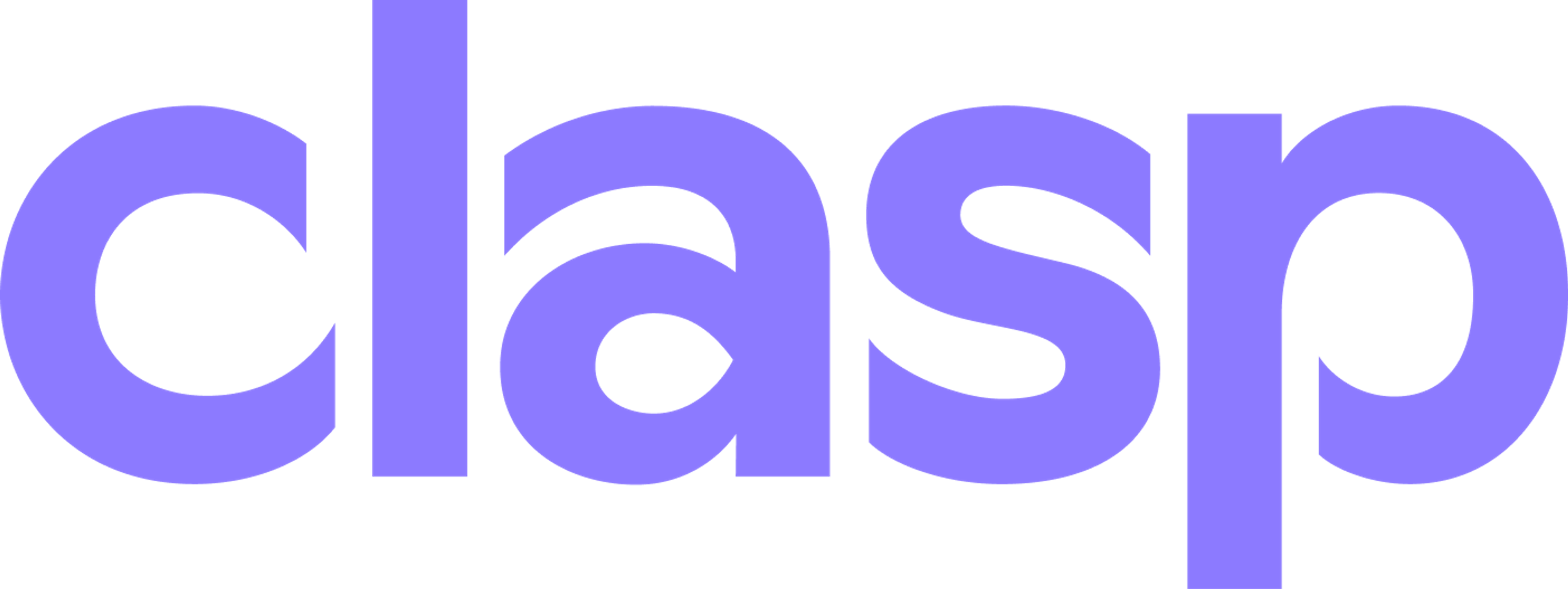
By Tess Michaels, Founder and CEO of Clasp
How Healthcare Leaders are Tackling Workforce Shortages in 2025
By 2026, the U.S. healthcare system faces a critical talent crisis. Nearly 1 in 4 healthcare employees are considering leaving their roles within the next year, and allied health turnover has climbed to a staggering 41% (Source: JLL, PMC). This growing workforce instability threatens both the operational viability of healthcare systems and the quality of care for millions of patients—during COVID-19, nurse understaffing led to a 17% increase in in-hospital deaths (Source: International Journal of Nursing Studies).
To address these challenges, HR leaders in healthcare must implement bold, innovative strategies to build and retain a sustainable workforce.
To better understand the path forward, I spoke with 11 visionary healthcare leaders—a mix of Chief People Officers, Chief Medical Officers, CEOs, and CNOs—representing systems that span urban hubs, rural communities, and underserved regions. From CommonSpirit Health and Trinity Health, the third and sixth largest hospitals in the U.S. respectively, to Memorial Sloan Kettering, nationally recognized as one of the top cancer centers in America, their perspectives reflect the unique challenges and opportunities in addressing this crisis.
Here’s what I learned:
1. Retention is the New Recruiting
Investing in a deliberate retention strategy is no longer optional—it’s a necessity. And while healthcare workforce shortages affect all types of systems, it’s clear the solutions must address the specific needs of each region, population, role, and let’s face it—generation.
At Mercy—the 16th largest hospital in the nation with 49 acute care and specialty hospitals, urgent care locations, imaging centers, and pharmacies—leaders like Chief Talent Acquisition Officer Scott Sell are rethinking traditional recruiting strategies to fix the leaky bucket. To put it bluntly, Scott said:
“With a shrinking talent market combined with a greater demand for healthcare services, relying on recruitment strategies from yesterday will not be the blueprint for tomorrow's success.”
This is particularly poignant coming from Mercy, which boasts a 25% boomerang rate, meaning 1 in 4 employees who leave eventually return. (See Scott’s tips for building high-performance, high-retention culture from our October webinar here.)
Marvin O’Quinn, former CEO of CommonSpirit Health, which employs 175,000 people across 24 states, emphasized not just the importance of innovative partnerships but also the pressing need to adapt to Gen Z’s expectations in order to hire and retain critical talent:
“Healthcare leaders must go beyond their comfort zones to develop partnerships and relationships that help them better find and bond with potential employees. Attitudes toward work and lifestyle have changed and continue to change, so healthcare leaders will have to be more innovative to ensure a sustainable workforce.”
Millennials and Gen Z increasingly value flexibility, preferring extended time off and fewer workdays, such as 3-day, 12-hour shifts (Source: Nurse Leader). Employers that adapt for these preferences see stronger engagement and reduced turnover.
2. Regional Shortages Require Regional Solutions
Of course, shortages are not felt the same in every state, or in every role. For example, according to the Health Resources and Services Administration, Georgia, California, and Washington face the highest nursing shortage rates in the country (26%-29%), while North Dakota, South Dakota and Utah actually face a surplus. (Source: HRSA) And though rural health systems often struggle with isolation, urban centers face fierce competition for talent.
David Sylvan, Chief Strategy Officer at University Hospitals, ranked among the Top 3 hospitals in Ohio, emphasized the importance of early intervention and community partnerships:
“We must reach all the way back in the supply chain and find ways to excite and attract young people in middle school or slightly beyond, and partner with educational institutions, community assets, and novel funding sources to create a pipeline for the future. This is even more important for those communities historically overlooked or ill-positioned to consider a career path in healthcare.”
With more than 32,000 employees, University Hospitals is the second-largest employer in Northeast Ohio, a state in which 63% of direct care nurses are considering leaving bedside care, yet 89% say they would stay if minimum staffing standards were enforced. (Source: ONA)
Clasp is uniquely positioned to address these challenges by connecting employers in underserved regions with educational institutions and students outside their current reach. A critical focus for us in 2025 is expanding solutions for employers located in "school deserts," areas with limited access to academic programs that train students for critical healthcare roles.
3. We Need to Build Inclusive Pathways to Talent
Addressing talent shortages also requires expanding the pipeline of candidates and eliminating barriers to entry. Diversity, Equity, and Inclusion (DEI) initiatives play a pivotal role in this effort. Leaders like Will Moss, Founder & CEO of HBCU Connect, the largest network of students and alumni from Historically Black Colleges & Universities, stressed that DEI initiatives are not just a moral imperative—they’re a strategic one:
“By tapping into the diverse talent pools at HBCUs, their graduates and other minority-serving institutions, we can unlock an even larger pool of skilled, passionate professionals ready to make an impact. Diversity should be more than a goal—but the catalyst for a resilient healthcare workforce.”
Financial barriers remain one of the biggest obstacles to accessing education and entering the healthcare field. With more than 90% of private loans requiring a co-signer—often a "code" for a wealthy parent—students from underserved backgrounds are disproportionately affected. This June, a survey revealed that 59% of current college students have considered dropping out due to financial stress. (Source: Ellucian)
Innovative models like Clasp’s retention-driven “precruitment” programs address this issue by meeting talent while they’re still in school, then providing upfront employment and debt repayment commitments upfront, with structured repayment after hire. These programs eliminate financial barriers, increase completion rates, and expand the talent pool.
Education leaders like Dr. Howard Purcell, President and CEO of the New England College of Optometry, have seen the value in partnering with operators like Clasp:
“As the first optometry school in the U.S. to partner with Clasp nearly three years ago, our students have gained direct access to career pathways with four leading optometry employers across more than ten states in the U.S. We are not only reshaping how we prepare future optometrists but also providing tangible benefits—covering two years of tuition for new talent and up to all four years through upskilling programs.”
Youth apprenticeship programs, employer-led training, and innovative education-to-career pathways are emerging as pivotal solutions for long-term success. Jenna Sandker, Director of Talent Acquisition at Memorial Sloan Kettering, sees these programs as transformative:
“By building programs that allow young talent to gain exposure, earn while they learn, and complete higher education at no cost, we can create a pipeline of skilled workers ready to fill the clinical talent gaps that are so urgently needed.”
4. AI & Technology Will Reshape Roles and Ease Burnout
There is no doubt among healthcare leaders that technology is reshaping how systems approach workforce challenges. Leaders like Dr. Carl Spear, EVP & Chief Medical Officer EssilorLuxottica, which employs 190,000 people globally, emphasizes not only that education and technology must work hand-in-hand, but that tech may be the solution to work-life balance:
“We will continue to promote and support education and incentives for doctors to provide care in underserved areas. Additionally, we will continue to leverage innovative technologies to supplement patient care and provide our doctors with work-life balance.”
“We will continue to promote and support education and incentives for doctors to provide care in underserved areas. Additionally, we will continue to leverage innovative technologies to supplement patient care and provide our doctors with work-life balance.” Carl Spear, EVP & Chief Medical Officer, EssilorLuxottica North America
From virtual nurses to AI-assisted radiologists, technology can also be a powerful tool for increasing career longevity. One of the most innovative models I’ve seen is at Trinity Health, which employs over 127,000 people.
Gay Landstrom, Trinity’s SVP and Chief Nursing Officer, joined us for our August webinar on cultivating new nursing talent, and says they were able to scale their TogetherTeam Virtual Connected Care™ delivery model to 62 nursing units across 11 states.
The program effectively utilizes nurses with at least 8 years of experiences as virtual advisors and caregivers, supporting and mentoring onsite junior nurses to deliver quality care, while increasing career longevity and retention of senior nurses. For context, the average nurse tenure in the U.S. is just 5 years. (Source: Becker’s)
“It took courage and, I think, a kind of pioneer spirit on the part of our nurses. I really wanted to make sure that we created a role for the experienced senior nurse so we could extend their career. This way, they didn't feel like they had to leave bedside care, retire, or find a desk job.”
Jalie Cohen, CHRO at Radiology Partners,a leading radiology practice serving more than 3,300 hospitals and other healthcare facilities in the U.S., focused on the role of technology in enhancing clinical capacity:
“One strategy is to leverage technology that enables physicians to reduce administrative burdens and devote more time to efficient, focused clinical diagnosis—a key approach to addressing the projected labor shortage in 2025.”
Gabrielle Finley-Hazle, President of Aurora Health Care, part of Advocate Health—the third-largest nonprofit integrated system in the United States employing more than 150,000 teammates with 68 hospitals—added that AI-driven recruitment processes could transform workforce planning.
“We will be leveraging virtual reality to attract talent when they are still in school and to help shape career pathways for current and future employees. In addition, the use of technology offers unique experiences beyond our traditional recruiting methods and sparks interest in nontraditional healthcare jobs early.”
“We will be leveraging virtual reality to attract talent when they are still in school and to help shape career pathways for current and future employees. In addition, the use of technology offers unique experiences beyond our traditional recruiting methods and sparks interest in nontraditional healthcare jobs early.” – Gabrielle Finley-Hazle, President Aurora Health Care
Conclusion
The leaders featured in this article represent some of the brightest minds tackling healthcare’s workforce crisis. Their willingness to share insights with Clasp speaks to the importance of collaboration, creativity, and courage in solving this challenge. And hearing directly from them reinforced one key takeaway: building a sustainable healthcare workforce is not just possible but essential. By investing in innovative partnerships, technology, and talent pipelines, we can create a future where healthcare systems thrive—and every patient receives the care they deserve.
At Clasp, we are proud to facilitate these discussions and support organizations in turning vision into action. Together, we can shape a resilient and thriving healthcare workforce for years to come.
Want to know more about Clasp?
Schedule a meeting with our team to explore how Clasp can help you build predictable talent pipelines, reduce turnover, and drive lasting retention through innovative solutions.


